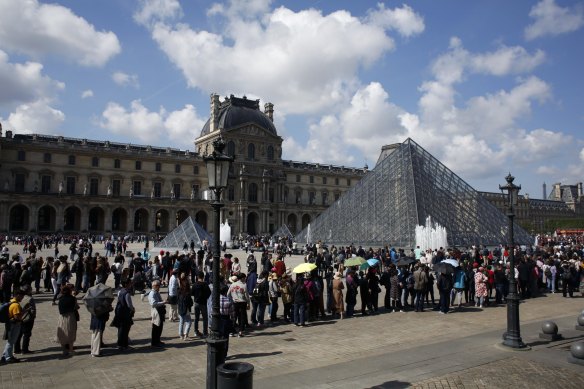I’m told that, typically, the room becomes so congested that visitors spend an average of only 50 seconds viewing the painting, and not everyone can get a clear view, especially children and those with mobility issues. Waiting times can run up to two hours. I’m shoved from side to side and as a husband and wife take pictures in front of the painting, their poor child is just about trampled by the crowd.
Activists threw soup at the glass protecting the world’s most famous painting. Credit: AP
Few people bother to look across the room to where the Louvre’s biggest painting hangs: The Wedding at Cana by Paolo Veronese. It is one of the most spectacular things I’ve seen.
But all this unseemly spectacle might be about to come to an end, before Mona Lisa’s reputation is forever ruined by annoying crowds and Instagrammers.
The museum’s administration, led by director Laurence des Cars, is exploring the idea – in collaboration with the Ministry of Culture – of relocating the painting to a dedicated underground chamber.
“At the heart of my mission as director is to welcome the public better,” des Cars told radio station France Inter last month. “It is always frustrating when our visitors’ experience is not up to standard, as is obviously the case with the Mona Lisa”.
The new room, if approved, is estimated to cost €500 million ($800 million) and would feature advanced climate control for preserving the artwork and enhanced security measures to protect it from vandalism or theft. It’s hoped it will improve the visitor experience and ensure the long-term preservation of the painting.

The Louvre attracts almost 9 million visitors a year, most of whom come to see the Mona Lisa.Credit: THIBAULT CAMUS
Funding it will be complex at a time when the French government is considering austerity measures across many sectors. The Louvre has capped crowds at 20,000 a day in recent times, down from 50,000, and hiked full-price admission 30 per cent to €22 ($36) in January as a result. But 40 per cent of visitors, namely European residents aged under 26, don’t have to pay.
Vincent Delieuvin, the painting’s chief curator, told French newspaper Le Figaro a dedicated chamber had been under consideration for a long time, “but this time everyone is in agreement”.
“It’s a large room, and the Mona Lisa is at the back, behind its security glass, so at first glance, it looks like a postage stamp. Leonardo da Vinci wanted to establish a face-to-face relationship between the painting and the person contemplating it.”
Loading
But the move has sparked varied reactions. Some visitors express excitement about the potential for a better viewing experience, while others worry that an underground setting might detract from the painting’s grandeur.
Michel Guerrin, editor-in-chief of Paris-based newspaper Le Monde, says isolating the Mona Lisa would “mark the end of an ideal, that of a painting as part of a unique journey, in a single museum, for the shared enjoyment of tourists, Parisians and art lovers alike”.
“The imbalance in expectations is too great,” he wrote. “No doubt the burdensome painting needs to be put away to win back those who think the Louvre is no longer for them. This banishment is necessary to restore peace.”
Still, perhaps it’s a nice problem to have. Many of France’s fine art museums now struggle to attract crowds and enough funding. The Louvre, home to more than 35,000 exhibited works, is designed to accommodate 4 million visitors a year, but receives more than twice that number.
Loading
And after all, if you can stomach the crowds, seeing the Mona Lisa is a bucket list-worthy experience. Just put the camera away.
Get a note directly from our foreign correspondents on what’s making headlines around the world. Sign up for the weekly What in the World newsletter here.

